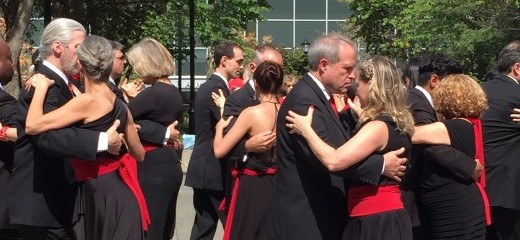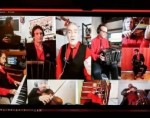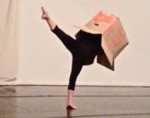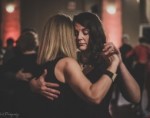
Photo: Maria Aldrete
Tierra
by Carolyn Merritt
Tango is a product of immigrants—a dance, music, and poetic tradition that arose when European, African, and internal migrants met in late 19
th-century Buenos Aires and Montevideo. So it felt right to perform tango in the lead-up to Pope Francis’s speech on immigration during his recent visit to Philadelphia for the World Meeting of Families (WMOF). That Francis is from Argentina and has publicly professed his affection for tango made it poetic. Organized by Meredith Klein of the Philadelphia Argentine Tango School, the group performances included a choreographed
milonga (the faster, more rhythmic, upbeat version of tango) to
No hay tierra como la mía (
There’s No Land Like Mine), and an improvisation to the tango known around the world,
La cumparsita.
Tango has come a long way in a century. In 1913, Pope Pius X declared the dance immoral. Less a reflection of the Catholic Church than the times—lots of people found the dance indecent, especially Argentines—these objections did little more than fan tango’s flames. It spread across the globe and thrived. In
his speech before Philadelphia’s Independence Hall, Pope Francis addressed other, more pressing moral dilemmas: specifically, the plight of immigrants in the U.S.; more generally, the integrity of the individual and of cultural and religious traditions in a globalized world. He spoke of the city’s Quaker roots, reminding us that Penn’s Woods was to be a haven for diversity and tolerance. He urged us all to remember our history, implored the country’s newest immigrants especially to hold onto their traditions, argued for pluralism as a “path to peace in our troubled world.” The themes of memory and remembrance—so cogent in Argentina and its tango—ran through his speech, threading together our movements, their roots, and his words.
In his opening remarks, preceding Pope Francis,
Archbishop Charles Chaput cited Alexander Hamilton to conjure the American Dream and our immigrant story: “This is a nation that no single ethnic group or privileged economic class
owns.” This merits debate, but it also evokes our
milonga lyrics (
No hay tierra como la mia/ There’s No Land Like Mine) and the
Andersonian paradoxes of
tierra. Spanish for ground, earth, land, soil—all tangible things—and for country, nation. But a country is a concept. Forget about the fact that the land was already peopled, that the freedoms upon which the U.S. was conceived are still not held equally by all who inhabit it. Standing on the site where the country was inscribed into being, Francis exposed the absence at its core. Born of belief, grounded in and transcending place, it is constantly made and remade through participation, struggle, and transformation.
So much was left unsaid. Given the politicization of immigration in the U.S., I’d hoped for more. Still, tierra and its meanings echoed throughout the day—in Francis’s allusions to ongoing struggles to embody our founding principles, in the performances of American multiculturalism, in the teary response of the crowd (some, recent immigrants)—evoking the gulf between land and country, between attachment and citizenship.
As we danced, I remembered Argentina—tierra that was also mine, that embraced me more lovingly than it did so many others (because of my nationality, my race, class, and education), more lovingly than mine does so many others (for quite similar reasons).
The weekend preceding the WMOF, Klein arranged for dancers representing the Philadelphia Argentine Tango School to perform in Love Park. The event was recorded and
a video welcoming Pope Francis to Philadelphia was produced. Following the taping, there was a one-hour
milonga (tango social dance) open to the community. Passersby stopped to watch and applaud. Television, print, and web media captured the event. A photograph appeared in the Philadelphia Inquirer and NBC aired a brief video of the event.
The Philadelphia Union of the Homeless also descended on Love Park that day, to protest the city’s spending on Pope Francis’s visit and to demand that Philadelphia “adopt a Housing First policy and place ALL homeless people in safe housing,” in one of its approximately 40,000 vacant properties. Media did not cover the protest.
__________
Stopped at a traffic light near Love Park days later, I see a man in a WMOF volunteer shirt approaching cars and asking for money. I can’t know for sure, but he could be homeless. A friend and I talk about how common this has become in Philadelphia. I wonder if the frequency makes it easier to pass by. Where would you begin, and end?
WMOF also established the
Francis Fund in collaboration with Philadelphia’s Project HOME, to address the needs of people struggling with hunger, homelessness, and poverty. The fundraising goal is $1.5 million.
__________
Alexander Hamilton was born out of wedlock in the West Indies and immigrated to the U.S. in his teens. He was an outlier among our founders, the majority of whom traced their roots to England. Even as they broke these ties to create a new nation, they imported decidedly British ideals into the country’s framework. High among these was an equation between private property, identity, and self-worth, and we feel its legacy to this day—it shaped slavery and race, and it has influenced housing policy and much more in the U.S.
Home ownership is our dream, carved at once into our imagination and our landscape. Homelessness has no place in this tierra.
Argentine Tango at World Meeting of Families, Philadelphia Argentine Tango School, Independence Mall, September 26.
By Carolyn Merritt
October 18, 2015










